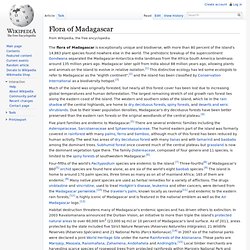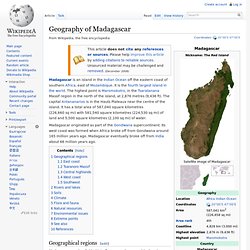

Pierre Henry
Provinces of Madagascar. Madagascar was divided into six "autonomous provinces" (faritany mizakatena): The provinces were dissolved as a result of the new regional subdivision and the constitutional referendum of 2007.

There was a time frame of thirty months (until October 2009) for the transition. Government of Madagascar. Deforestation in Madagascar. Illegal slash and burn practise in the region west of Manantenina.

Deforestation in Madagascar is an ongoing environmental issue. Deforestation[1] with resulting desertification, water resource degradation and soil loss has affected approximately 94% of Madagascar's previously biologically productive lands. Since the arrival of humans 2000 years ago, Madagascar has lost more than 90% of its original forest.[2] 70% of the forest cover of Madagascar was destroyed between 1895 and 1925, while Madagascar was under French rule.[3] Since 1953, half of the remaining forest has been lost.[4] Largely due to deforestation, the country is currently unable to provide adequate food, fresh water and sanitation for its fast growing population.[5][6] One major cause of deforestation has been the introduction of coffee as a cash crop during the French colonial period.[3] Ecology. Fauna of Madagascar. The fauna of Madagascar is a part of the wildlife of Madagascar.

Madagascar has been an isolated island for about 70 million years, breaking away from Africa around 165 million years ago, then from India nearly 100 million years later. This isolation led to the development of a unique endemic fauna. Before humans arrived about 2,000 years ago, there were many large and unusual animals living there, descended from species that were originally present when Madagascar became an island, or from species that later crossed the sea to Madagascar. Ecological niches were often filled by animals with quite different histories from those on the African mainland, often leading to convergent evolution. Flora of Madagascar. The flora of Madagascar is exceptionally unique and biodiverse, with more than 80 percent of the island's 14,883 plant species found nowhere else in the world.

The prehistoric breakup of the supercontinent Gondwana separated the Madagascar-Antarctica-India landmass from the Africa-South America landmass around 135 million years ago. Madagascar later split from India about 88 million years ago, allowing plants and animals on the island to evolve in relative isolation.[1] This distinctive ecology has led some ecologists to refer to Madagascar as the "eighth continent",[2] and the island has been classified by Conservation International as a biodiversity hotspot.[3]
Climate. Geography. Geography of Madagascar. Madagascar is an island in the Indian Ocean off the eastern coast of southern Africa, east of Mozambique.

It is the fourth largest island in the world. The highest point is Maromokotro, in the Tsaratanana Massif region in the north of the island, at 2,876 metres (9,436 ft). The capital Antananarivo is in the Hauts Plateaux near the centre of the island. It has a total area of 587,040 square kilometres (226,660 sq mi) with 581,540 square kilometres (224,530 sq mi) of land and 5,500 square kilometres (2,100 sq mi) of water.